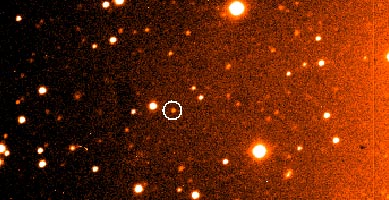
 |
Caliban is a character from Shakespeare's play The Tempest; a savage and deformed slave of the magician Prospero, and is the son of the witch Sycorax who imprisoned the fairy Ariel for disobedience. In The Tempest, Prospero frees Ariel from Sycorax's spell and enslaves Caliban.
Discovered by Brett Gladman, Phil Nicholson, Joseph Burns, and JJ Kavelaars using the 200 inch Hale telescope; the first images were taken 1997 Sept 6 and 7.
 The image above is the discovery image of S/1997 U 1; the one to the right is S/1997 U 2.
The image above is the discovery image of S/1997 U 1; the one to the right is S/1997 U 2.
Prior to this discovery, Uranus was the only one of the gas giants not known to have "irregular" moons, that is, ones whose orbits are not direct and approximately in the plane of the planet's equator.
Like the other irregular moons (eg. Jupiter's outer 8 moons, Phoebe and Nereid), these are probably captured asteroids. It is highly unlikely that they could have been formed initially in these orbits.
The composition of the two moons, according Nicholson, "is probably a plum-pudding mixture of rocks and ice." Both moons are unusually red in color which may suggest a historical link with the Kuiper Belt.
These are the dimmest moons ever to have been imaged with a ground-based telescope.
Imaged by Voyager 2 in 1986; discovered in 1999 by Erich Karkoschka of the Lunar and Planetary Lab of The University of Arizona in Tucson.
It's orbit is nearly identical to that of Belinda, about 75,000 km from Uranus.
It is about 40 km in diameter.